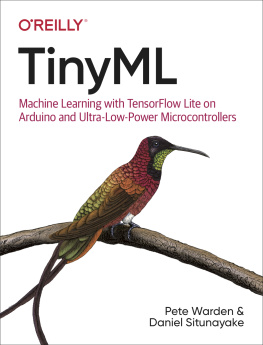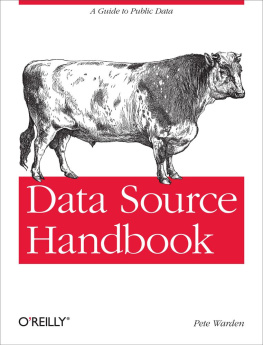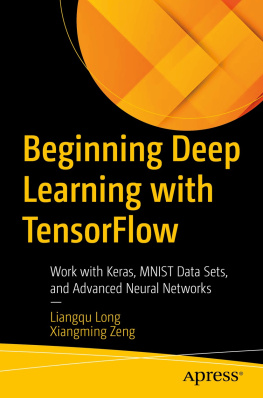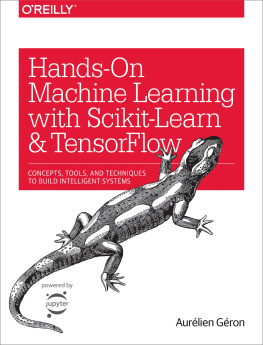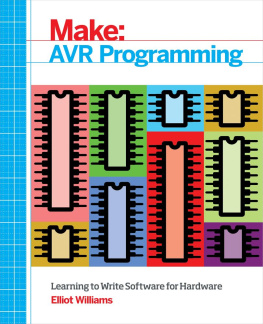TinyML
by Pete Warden and Daniel Situnayake
Copyright 2020 Pete Warden and Daniel Situnayake. All rights reserved.
Printed in the United States of America.
Published by OReilly Media, Inc., 1005 Gravenstein Highway North, Sebastopol, CA 95472.
OReilly books may be purchased for educational, business, or sales promotional use. Online editions are also available for most titles (http://oreilly.com). For more information, contact our corporate/institutional sales department: 800-998-9938 or corporate@oreilly.com .
- Acquisitions Editor: Mike Loukides
- Development Editor: Nicole Tach
- Production Editor: Beth Kelly
- Copyeditor: Octal Publishing, Inc.
- Proofreader: Rachel Head
- Indexer: WordCo, Inc.
- Interior Designer: David Futato
- Illustrator: Rebecca Demarest
- December 2019: First Edition
Revision History for the First Edition
- 2019-12-13: First Release
- 2020-08-07: Second Release
See http://oreilly.com/catalog/errata.csp?isbn=9781492052043 for release details.
The OReilly logo is a registered trademark of OReilly Media, Inc. TinyML, the cover image, and related trade dress are trademarks of OReilly Media, Inc. TinyML is a trademark of the tinyML Foundation and is used with permission.
While the publisher and the authors have used good faith efforts to ensure that the information and instructions contained in this work are accurate, the publisher and the authors disclaim all responsibility for errors or omissions, including without limitation responsibility for damages resulting from the use of or reliance on this work. Use of the information and instructions contained in this work is at your own risk. If any code samples or other technology this work contains or describes is subject to open source licenses or the intellectual property rights of others, it is your responsibility to ensure that your use thereof complies with such licenses and/or rights.
978-1-492-05204-3
[LSI]
Preface
Something about electronics has captured my imagination for as long as I can remember. Weve learned to dig rocks from the earth, refine them in mysterious ways, and produce a dizzying array of tiny components that we combineaccording to arcane lawsto imbue them with some essence of life.
To my eight-year-old mind, a battery, switch, and filament bulb were enchanting enough, let alone the processor inside my familys home computer. And as the years have passed, Ive developed some understanding of the principles of electronics and software that make these inventions work. But what has always struck me is the way a system of simple elements can come together to create a subtle and complex thing, and deep learning really takes this to new heights.
One of this books examples is a deep learning network that, in some sense, understands how to see. Its made up of thousands of virtual neurons, each of which follows some simple rules and outputs a single number. Alone, each neuron isnt capable of much, but combined, andthrough traininggiven a spark of human knowledge, they can make sense of our complex world.
Theres some magic in this idea: simple algorithms running on tiny computers made from sand, metal, and plastic can embody a fragment of human understanding. This is the essence of TinyML, a term that Pete coined and will introduce in . In the pages of this book, youll find the tools youll need to build these things yourself.
Thank you for being our reader. This is a complicated subject, but weve tried hard to keep things simple and explain all the concepts that youll need. We hope you enjoy what weve written, and were excited to see what you create!
Daniel Situnayake
Conventions Used in This Book
The following typographical conventions are used in this book:
ItalicIndicates new terms, URLs, email addresses, filenames, and file extensions.
Constant widthUsed for program listings, as well as within paragraphs to refer to program elements such as variable or function names, databases, data types, environment variables, statements, and keywords.
Constant width boldShows commands or other text that should be typed literally by the user.
Constant width italicShows text that should be replaced with user-supplied values or by values determined by context.
Tip
This element signifies a tip or suggestion.
Note
This element signifies a general note.
Warning
This element indicates a warning or caution.
Using Code Examples
Supplemental material (code examples, exercises, etc.) is available for download at https://tinymlbook.com/supplemental.
If you have a technical question or a problem using the code examples, please send email to .
This book is here to help you get your job done. In general, if example code is offered with this book, you may use it in your programs and documentation. You do not need to contact us for permission unless youre reproducing a significant portion of code. For example, writing a program that uses several chunks of code from this book does not require permission. Selling or distributing examples from OReilly books does require permission. Answering a question by citing this book and quoting example code does not require permission. Incorporating a significant amount of the example code from this book into your products documentation does require permission.
We appreciate, but generally do not require, attribution. An attribution usually includes the title, author, publisher, and ISBN. For example: TinyML by Pete Warden and Daniel Situnayake (OReilly). Copyright Pete Warden and Daniel Situnayake, 978-1-492-05204-3.
If you feel your use of code examples falls outside fair use or the permission given above, feel free to contact us at .
OReilly Online Learning
Note
For more than 40 years, OReilly Media has provided technology and business training, knowledge, and insight to help companies succeed.
Our unique network of experts and innovators share their knowledge and expertise through books, articles, and our online learning platform. OReillys online learning platform gives you on-demand access to live training courses, in-depth learning paths, interactive coding environments, and a vast collection of text and video from OReilly and 200+ other publishers. For more information, please visit http://oreilly.com.
How to Contact Us
Please address comments and questions concerning this book to the publisher:
- OReilly Media, Inc.
- 1005 Gravenstein Highway North
- Sebastopol, CA 95472
- 800-998-9938 (in the United States or Canada)
- 707-829-0515 (international or local)
- 707-829-0104 (fax)
We have a web page for this book, where we list errata, examples, and any additional information. You can access this page at https://oreil.ly/tiny.
Email to comment or ask technical questions about this book.
For news and more information about our books and courses, see our website at http://www.oreilly.com.
Find us on Facebook: http://facebook.com/oreilly
Follow us on Twitter: http://twitter.com/oreillymedia
Watch us on YouTube: http://www.youtube.com/oreillymedia

